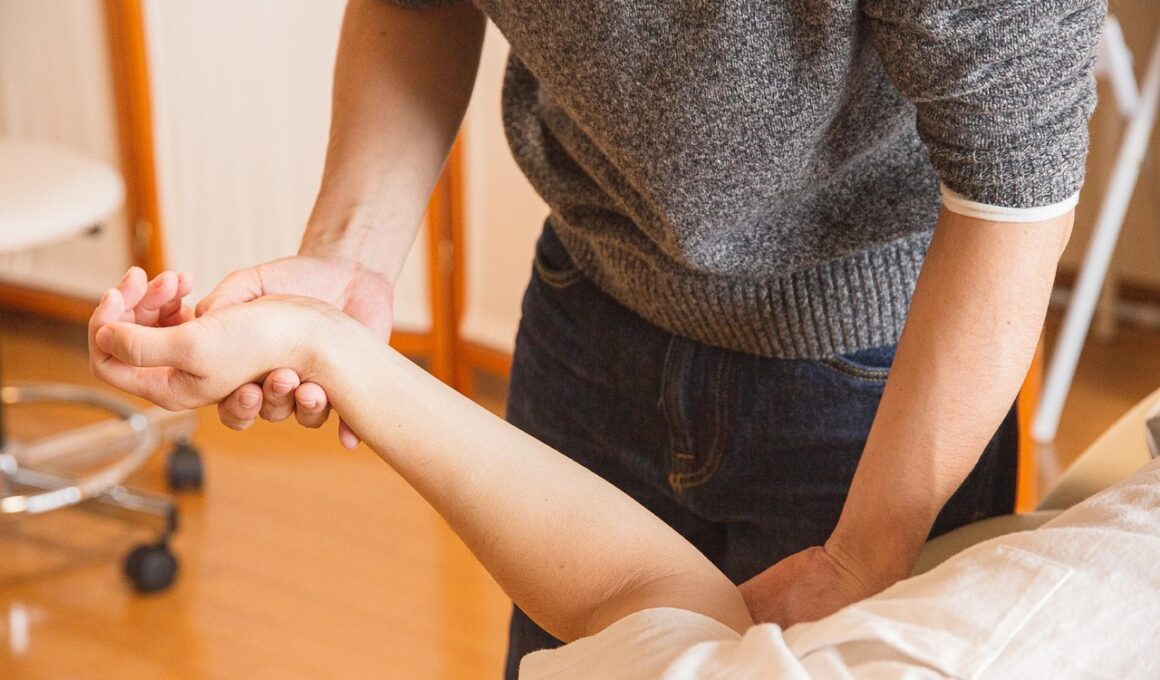Advancements in Occupational Therapy for Musculoskeletal Injury Recovery
Occupational therapy plays a crucial role in the rehabilitation of individuals suffering from musculoskeletal injuries. Recent advancements in therapy methodologies emphasize a patient-centered approach that incorporates evidence-based practices tailored to individual needs. This is particularly evident in the use of technology, such as virtual reality, to create immersive environments for rehabilitation exercises. Utilizing virtual reality can enhance motivation as patients engage in exercises that mimic real-life activities. Furthermore, the integration of biofeedback mechanisms allows therapists to provide immediate corrective feedback during rehabilitation workouts, which can significantly improve the recovery process. Innovative assessments help identify specific areas of impairment, facilitating targeted interventions. Research into manual therapy techniques has also yielded promising results, showing that they can enhance mobility and decrease pain levels for patients. Coupling these approaches with strength training and flexibility exercises forms a well-rounded rehabilitation plan. Collaboration between occupational therapists and other medical professionals ensures a holistic treatment plan. This synergy often leads to better outcomes for patients striving to return to their normal routines.
Research has shown that tailored rehabilitation programs are essential for effective recovery. For example, occupational therapists utilize a variety of assessments to determine the specific requirements of each person. Evaluating strength, range of motion, and functional abilities helps in crafting an individualized treatment strategy. By collaborating with physiotherapists, occupational therapists ensure that their patients receive comprehensive care aimed at addressing both physical and psychological aspects of recovery. The use of technology, such as teletherapy, has grown significantly, particularly following the recent global events. Teletherapy allows for remote sessions, making therapy accessible to those who may have difficulty attending in-person appointments. This method of delivery has demonstrated effectiveness, especially in reaching broader demographics. Additionally, regular follow-ups through video conferencing facilitate ongoing adjustments to treatment plans. This adaptability can lead to improved rehabilitation results, as therapists can monitor progress and modify exercises as necessary. Engaging patients in goal-setting through digital platforms enhances their motivation. As we move forward, the incorporation of patient feedback into rehabilitation programs will likely play a key role in maximizing their effectiveness.
Incorporating Holistic Approaches in Therapy
Holistic approaches in occupational therapy acknowledge the interplay between the mind and body during recovery. Strategies encompassing mental health interventions can drastically influence physical outcomes for individuals recovering from musculoskeletal injuries. Techniques such as mindfulness, relaxation training, and cognitive-behavioral therapy help patients manage pain and reduce anxiety associated with rehabilitation. Integrating these mental health techniques into therapy sessions fosters overall well-being. For instance, occupational therapists may teach patients mindfulness techniques to incorporate during painful exercises, enhancing their coping mechanisms. Strengthening the mental aspect of recovery allows individuals to engage more fully in their rehabilitation process. Additionally, support groups can significantly benefit patients, providing a space for sharing experiences and strategies. These groups often foster a sense of community, which can improve emotional health. Researchers emphasize the effectiveness of combining physical and mental health strategies for improved recovery rates. Likewise, occupational therapists are increasingly recognizing the need to adjust therapeutic environments to optimize patient experiences. Creating welcoming and non-stimulating surroundings is key, aiding patients in feeling secure during therapy sessions.
Progress in understanding pain mechanisms has led to the development of better pain management strategies within occupational therapy. Traditional methods of pain relief, while still relevant, are increasingly being supplemented with advanced modalities such as therapeutic ultrasound and electrical stimulation. These methods aim to reduce inflammation and promote tissue healing effectively. For example, using therapeutic ultrasound can enhance circulation in injured areas, expediting recovery timelines. On the other hand, electrical stimulation helps alleviate discomfort and enhances muscle strength in affected regions. Manual therapy techniques are also crucial for restoring joint function and enhancing mobility. Occupational therapists are now better equipped with knowledge regarding the physiological factors of pain, allowing them to tailor interventions that can address specific concerns. As more research is conducted, it becomes clear that individualized approaches that combine multiple pain relief techniques are often the most effective. Ultimately, patient education regarding pain management is vital, ensuring that individuals are actively involved in their recovery journey and understand the rationale behind treatment options. This engagement can foster improved adherence to rehabilitation programs and lead to more successful outcomes.
Technology-Enhanced Rehabilitation
The implementation of technology in occupational therapy has transformed the landscape of rehabilitation for musculoskeletal injuries. Advanced tools such as wearable devices and mobile applications provide therapists with real-time data regarding patient progress. These technologies not only track physical activity and progress but also provide immediate feedback that informs treatment adjustments. For instance, wearable sensors can monitor joint movements, helping therapists better understand their patients’ mechanics and pinpoint underlying issues. This data can be invaluable for assessing recovery and modifying interventions as necessary. Mobile applications often enhance patient engagement by offering guided rehabilitation exercises and tracking systems. Using such tools empowers patients, encouraging them to take an active role in their healing process. Moreover, gamification of therapeutic exercises has shown promising results in increasing participation and enjoyment during rehabilitation. Elements of game design can motivate patients to complete exercises while minimizing perceived effort. Therapists have noted that these technological advancements contribute to improved outcomes and adherence rates. As more innovative tools emerge, the potential to revolutionize rehabilitation practices becomes greater, particularly for individuals recovering from musculoskeletal injuries.
A growing trend in occupational therapy is the focus on preventative care alongside rehabilitation efforts. Preventing recurrence of musculoskeletal injuries is vital to the long-term success of rehabilitation programs. Occupational therapists are now increasingly involved in educating patients about injury prevention, helping them identify risk factors in their daily lives. This involves assessing ergonomic practices in workplaces or at home and advocating for safer techniques. Providing personalized education on proper body mechanics can significantly reduce the risk of further injuries. Additionally, incorporating strengthening and flexibility exercises into routine practices can enhance functional capacity and resilience against future injuries. Patients are taught about the importance of maintaining physical activity and engaging in warm-up exercises before starting any strenuous activity. Overall, a proactive approach to rehabilitation emphasizes the necessity of understanding one’s limits and recognizing early signs of discomfort. By fostering a culture of prevention, occupational therapists contribute to holistic health and wellness outcomes. This shift towards preventive care represents an exciting development in the field, promising not only recovery but also long-term health maintenance among those recovering from injuries.
Future Directions in Occupational Therapy
As we look to the future of occupational therapy in musculoskeletal injury recovery, the influence of ongoing research and technological advancement plays a pivotal role. Continuous development within the field is essential to incorporate best practices and innovative solutions. New studies exploring various treatment methodologies will further enhance our understanding and effectiveness of rehabilitation practices. The embrace of interdisciplinary collaboration among healthcare providers will become even more crucial as patients’ needs grow increasingly complex. Such collaboration can lead to holistic treatment plans that address the multifaceted aspects of recovery. Additionally, as virtual and augmented reality technologies advance, we can expect even greater integration into therapy sessions. These immersive experiences carry the potential to engage patients in ways never before imagined, easing the rehabilitation process. Moreover, the establishment of formalized mentorship programs for undergraduate therapists will allow new professionals to benefit from experienced practitioners. Ensuring that future occupational therapists are well-equipped with the latest knowledge and skills will be vital. As we move forward, the ongoing commitment to critical assessment and adapting practices will guide the evolution of rehabilitation in optimally meeting patient needs.
Ultimately, advancements in occupational therapy for musculoskeletal injury recovery highlight the dynamic nature of rehabilitation practices. Through the incorporation of technology, holistic approaches, and a focus on preventative care, professionals in the field are better equipped to serve patients’ evolving needs. The increased emphasis on collaboration and evidence-based approaches facilitates the delivery of high-quality care. This continuous striving towards improvement underscores the profession’s commitment to enhancing outcomes and overall patient satisfaction. As we navigate ongoing changes in healthcare, the commitment to research and innovation remains strong. The future of occupational therapy is bright, poised to embrace new challenges while pushing boundaries to achieve optimal results. Ongoing professional development and adaptation to emerging trends will ensure that therapists can effectively address musculoskeletal injuries. Encouraging patient involvement in their rehabilitation decisions will further foster positive outcomes. By aligning therapy practices with individual patient goals, occupational therapy can continue to transform lives significantly. Overall, advancements in occupational therapy not only enhance recovery processes but also empower individuals to reclaim their independence and lead healthier lives, marking a new era in injury rehabilitation.


